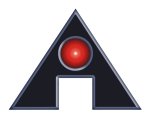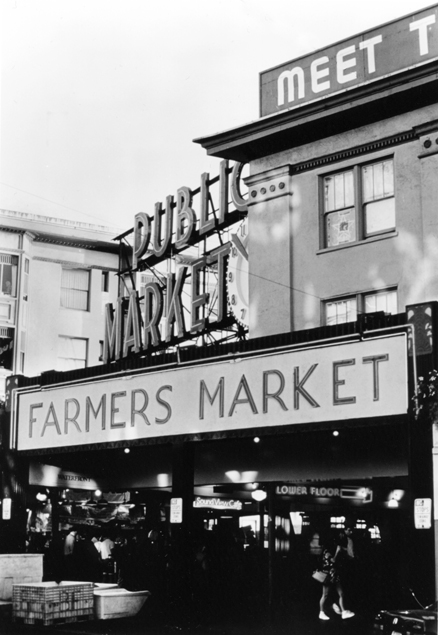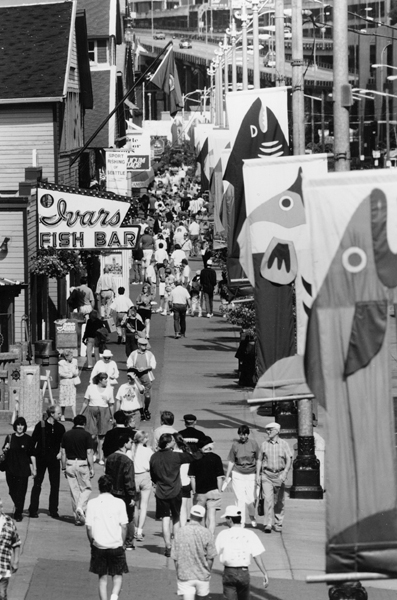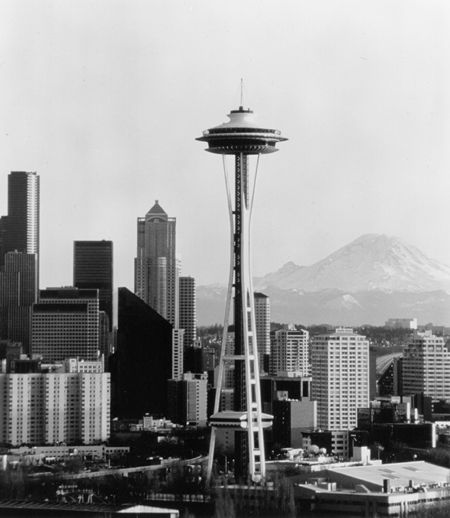 Seattle:
The Emerald City
Seattle:
The Emerald City Seattle:
The Emerald City
Seattle:
The Emerald CityBuilt on seven hills,
with unmatched mountain and water views, the wealth of natural beauty in and
around Seattle astonishes first-time visitors. Bounded on the west by Puget
Sound, an inland arm of the Pacific Ocean, and on the east by Lake Washington,
the city occupies a north-south corridor, slender at the waist, with hundreds of
miles of salt and freshwater shore-line literally touch the city’s boundaries.
The Cascade mountain range is east of the city, and the Olympic Mountains are to
the west. Thousands of square miles of evergreen forest extend out from the
city, and, on a clear day, the views of mountains and water are spectacular.
Seattle is a major
port, transportation hub, and manufacturing center and the principal city of
Washington State and of the Pacific Northwest.
Some of Seattle’s
best-known attractions are the Space Needle, Pike Place Market, Pioneer Square,
Woodland Park Zoo, Waterfront, Ballard Locks, and the new Experience Music
Project. These urban landmarks are clustered in pedestrian-scale sections, best
savored on foot. Central business district buses are free, and the Monorail
speeds quickly between downtown and the Seattle Center (site of both the Space
Needle and the Experience Music Project).
Seattle has a mild
climate all year round. The Olympic Mountains protect the Puget Sound area from
heavy rainfall and high winds from the west. On the east, the Cascade Mountains
shield the area from winter cold. Winter days are short, but summer days are
long, with16 hours of daylight in midsummer. The average summer temperature is
73 degrees (22.8 C), and maximum afternoon temperatures of 90 degrees (32.2 C)
or more are uncommon. Average yearly rainfall in Seattle is 36.2 inches (92 cm).
Here are some “best
bets” for a Seattle Sunday (or any day for that matter). Some are designed for
rain, some for shine. Some will take a few minutes, some a whole day. Pike Place
Market, Pioneer Square, and the Waterfront are in walking distance from the
Washington State Convention and Trade Center and the conference hotels.

The in-city farmers’ market so captures the essence of Seattle it is on almost everyone’s must-visit list. The Market occupies a nine-acre historic district and offers a profusion of vegetables, flowers, fish, baked goods and crafts from more than 100 farmers and 150 craftsmen. There are dozens of cafes. Hours are 10 a.m.–6 p.m. Monday through Saturday and 11 a.m. – 5 p.m. on Sunday. Many of the restaurants stay open until late in the evening. Pike Place Market is a great place to buy handicrafts, to eat, to people-watch, and to view the harbor.
Pioneer Square was settled soon after Seattle was founded in 1851. This is the site of the Skid Road (along Yesler Way) to skid logs downhill to the sawmill and the waterfront. Pioneer Square’s handsome brick buildings were built after the Great Fire of 1889. Pioneer Square has scores of interesting shops, antique galleries, and ethnic restaurants and more art galleries per square foot than any other city in the US. The underground tour of the old storefronts beneath the current-day Pioneer Square provides a glimpse of Seattle, circa 1889.
 The Waterfront
The WaterfrontSeattle’s waterfront, once known as “the Gold Rush Strip” stretches from Pier 51 on the south to Pier 70 on the north. It’s a popular area for strolling, shopping, dining, and exploring. Pier 70 houses a complex of shops and restaurants in a restored wharf. Waterfront Park is at Pier 57, with its public fishing pier, fish and chip bars, and import houses with merchandise from around the world. Ye Olde Curiosity Shop at Pier 54 specializes in souvenirs and curiosities, including two mummies (Sylvester and Sylvia). You can also take a ferry ride or visit Maritime Park. While visiting the waterfront, ride on the vintage trolley system and get a feeling of some of Seattle’s historic past.
One of Seattle’s
most popular attractions, the Ballard Locks have served since 1917 as a watery
elevator to lift vessels from the saltwater of Puget Sound to freshwater lakes,
and vice-versa. First-timers are often mesmerized by the sight of a lock full of
vessels being raised or lowered from 6 to 26 feet (depending on the tide).
Seventy-four acres of arts, entertainment, recreation, shopping, dining, and educational and cultural adventures awaits you at the Seattle Center. Home of the 1962 World’s Fair, Seattle Center hosts the Space Needle, the Pacific Science Center, the Experience Music Project, Fun Forest Amusement Park, Seattle Children’s Museum, and the historic Seattle Center Monorail, which now connects to the Westlake Center.

Seattle’s landmark,
which opened in 1962, provides visitors with a matchless view of the city and
Puget Sound. On a clear day, visitors also spot Mount Rainier, Mount Baker, and
the Cascade and Olympic ranges from the top-level observation deck. Hours for
the observation deck are Sunday – Thursday: 9:00 a.m. -11: 00 p.m., Friday and
Saturday: 9:00 a.m. - 12:00 midnight.
The Experience Music
Project is the new interactive music museum located at the Seattle Center.
Designed by Frank Gehry, The Experience Music Project is Seattle’s most
unusual building—both in shape (a “blob”?) and in color (red, blue, gold,
silver, and purple). Inside you will find kiosks offering interactive tours of
rock history, a treasure trove of musical memorabilia (including Bob
Dylan’s1949 Martin guitar, Jimi Hendrix’s Woodstock guitar, Eric Clapton’s
Fender Stratocruiser, and Janis Joplin’s “groovy pants”), and much, much
more.
Hours are 9:00 a.m. to
11:00 p.m. daily.
The Woodland Park Zoo, one of the nation’s ten best, is known for its natural habitats, especially a large, lush gorilla exhibit and tropical forest for elephants. The five-acre African savanna is home to hippos, lions, zebras, springboks, and giraffes. Don’t miss the walk through the swamp or the trip through the Nocturnal House, home of the shy, seldom seen creatures of the night. The zoo is open daily from 9:30 a.m. to 6:00 p.m.
Language
English
Currency
The American Dollar,
with one dollar equaling 100 cents. Approximate rates of exchange in mid-January
2001 were:
US$1.00 = .67 British
Pounds
US$1.00 = 1.50
Canadian Dollars
US$1.00 = 6.9 French
Francs
US$1.00 = 2.06 German
Marks
US$1.00 = 115.69
Japanese Yen
US$1.00 = 1.05 Euros
All major credit cards
are accepted in all hotels, most restaurants and department stores.
Banking
Banks in downtown
Seattle are usually open Monday–Friday from 9:00 am–5:00 pm. Some banks are
open Saturdays from 9:00 am-4:00 pm. Automatic teller machines are available
throughout town.
Taxes
The current sales tax
in Seattle, Washington is 8.6%.
Tipping
In general, a tip of
15 percent is given to waiters, waitresses, hairdressers, taxi drivers, etc.
Bellhops, doormen, porters, etc., at hotels, airports and railway stations are
generally paid $1.00 per item of luggage.
Visitor Information
Visitor information is
available in the Washington State Convention & Trade
Center. This one-stop
center provides visitors with tourist information and services such as travel
planning, information on activities, and attractions.
Visitor Information
800 Convention Place
Washington State Convention & Trade Center
Center-Lobby Level
(206) 461-5840
Restaurants
| Category | Breakfast | Lunch |
Dinner |
| Fast Food | $3-4 | $5-7 |
$8-10 |
| Economy | $5 | $8-12 | $10- |
| Deluxe | $15-25 | $15-35 | $25 |